A knife steel chart provides a detailed overview of steel properties‚ types‚ and applications‚ helping users select the best steel for their needs. It offers insights into hardness‚ corrosion resistance‚ and edge retention‚ making it an essential tool for knife enthusiasts and professionals. These charts are widely available in PDF format for easy reference.
1.1 Importance of Knife Steel Charts
Knife steel charts are essential for understanding the properties and performance of various steel types. They help users make informed decisions by comparing factors like hardness‚ corrosion resistance‚ and edge retention. These charts are vital for knife enthusiasts‚ collectors‚ and professionals‚ as they provide a clear guide to selecting the right steel for specific applications. By referencing these charts‚ individuals can optimize their tools for durability‚ functionality‚ and aesthetic appeal‚ ensuring the best performance for their intended use.
1.2 Purpose of a Knife Steel Chart
1.3 Key Factors in Knife Steel Selection
Key factors in knife steel selection include hardness‚ toughness‚ corrosion resistance‚ and edge retention. Carbon content significantly impacts hardness and wear resistance‚ while chromium enhances corrosion resistance. Alloying elements like vanadium improve toughness and edge retention. Understanding these factors helps users choose the right steel for their needs‚ whether for durability‚ rust resistance‚ or sharpness. These elements are crucial for optimizing knife performance in various applications‚ from culinary use to outdoor activities.
Key factors in knife steel selection include hardness‚ toughness‚ corrosion resistance‚ and edge retention. Carbon content influences hardness and wear resistance‚ while chromium enhances corrosion resistance. Alloying elements like vanadium improve toughness and edge retention. Understanding these factors helps users choose the right steel for their needs‚ ensuring optimal performance in various applications‚ from culinary use to outdoor activities. These elements are crucial for balancing durability‚ sharpness‚ and resistance to environmental factors.
1.4 Overview of the Knife Steel Chart PDF
A knife steel chart PDF provides a comprehensive guide to understanding knife steel properties and compositions. It includes detailed tables‚ graphs‚ and comparisons of various steel types‚ such as stainless‚ carbon‚ and tool steel. The chart highlights key performance metrics like hardness‚ corrosion resistance‚ and edge retention. It also categorizes steels by their applications‚ making it easier for users to select the right steel for their needs. This resource is invaluable for knife enthusiasts‚ manufacturers‚ and collectors seeking detailed‚ organized information.
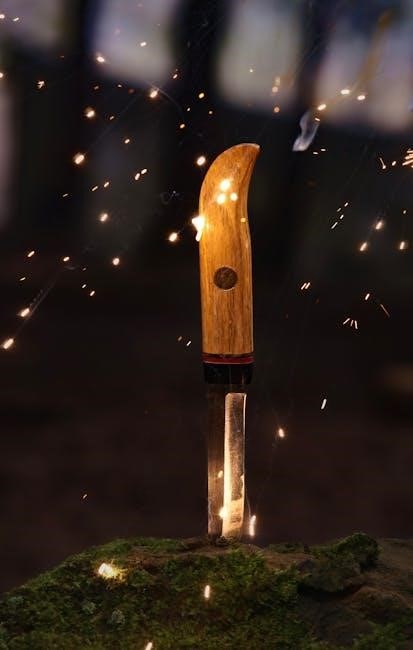
Understanding Knife Steel Composition
Knife steel composition determines a blade’s performance‚ with elements like carbon‚ chromium‚ and vanadium influencing hardness‚ corrosion resistance‚ and edge retention. A steel chart provides detailed insights.
2.1 Basic Elements in Knife Steel
Knife steel primarily consists of carbon‚ chromium‚ and other alloying elements. Carbon enhances hardness‚ edge retention‚ and wear resistance. Chromium improves corrosion resistance and strength; Other elements like vanadium or manganese may be added to boost specific properties‚ such as toughness or heat resistance. These elements combine to create steel grades with unique performance characteristics‚ as detailed in knife steel charts.
2.2 Role of Carbon in Knife Steel
Carbon is the primary element in knife steel‚ significantly influencing hardness‚ edge retention‚ and wear resistance. Higher carbon content increases strength and sharpness but may reduce toughness. It enhances the steel’s ability to hold a sharp edge and resist abrasion. However‚ excessive carbon can make the steel more brittle. Balancing carbon levels is critical for achieving optimal blade performance‚ as detailed in knife steel composition charts.
2.3 Role of Chromium in Knife Steel
Chromium is a crucial element in knife steel‚ enhancing hardness‚ corrosion resistance‚ and toughness. It forms a protective layer on the blade‚ reducing rust and wear. Higher chromium levels are common in stainless steels‚ making them ideal for wet or corrosive environments. Chromium also improves edge retention and durability without compromising sharpness. Knife steel charts often highlight chromium’s percentage‚ showing its impact on steel performance and suitability for various applications.
2.4 Other Alloying Elements in Knife Steel
Beyond carbon and chromium‚ other alloying elements like vanadium‚ molybdenum‚ and nickel play significant roles. Vanadium enhances edge retention and wear resistance‚ while molybdenum improves strength and heat resistance. Nickel boosts toughness and corrosion resistance‚ especially in stainless steels. These elements combine to create high-performance steels‚ each tailored for specific tasks. Knife steel charts detail these compositions‚ helping users understand how each element contributes to the blade’s overall performance and durability.

Types of Knife Steel
Knife steel types include carbon‚ stainless‚ tool‚ Damascus‚ and high-carbon stainless steel. Each offers unique properties like strength‚ corrosion resistance‚ and edge retention for specific uses.
3.1 Carbon Steel
Carbon steel‚ known for its high carbon content‚ enhances hardness and edge retention‚ making it ideal for high-performance knives. Often used in professional and outdoor knives‚ it offers exceptional durability and sharpness. Popular grades like 1095 and 15N20 are favored for their strength and edge-holding capabilities‚ though they require regular maintenance due to lower corrosion resistance compared to stainless steel.
3.2 Stainless Steel
Stainless steel is prized for its exceptional corrosion resistance‚ durability‚ and low maintenance‚ making it ideal for everyday use. Containing at least 10.5% chromium‚ it resists rust and environmental degradation. Popular grades like 420J1‚ 420J2‚ 420HC‚ and 440C offer varying levels of hardness and edge retention. While it may not hold an edge as well as carbon steel‚ advancements in metallurgy have improved its performance‚ balancing toughness‚ corrosion resistance‚ and sharpening ease for versatile applications.
3.3 Tool Steel
Tool steel is renowned for its exceptional hardness and wear resistance‚ making it ideal for high-wear applications. It is often used in industrial and heavy-duty knives due to its durability and ability to maintain sharpness under extreme conditions. Popular grades like D2 and A2 offer high carbon content‚ enhancing edge retention and toughness. However‚ tool steel may lack corrosion resistance compared to stainless steel. It is a preferred choice for professionals needing reliable performance in demanding environments‚ with proper heat treatment further optimizing its properties.
3.4 Damascus Steel
Damascus steel is prized for its distinctive wavy patterns and exceptional strength. It is crafted through a forge-welding process‚ combining multiple steel types to enhance hardness‚ flexibility‚ and edge retention. Known for its aesthetic appeal and durability‚ Damascus steel is often used in high-end knives. However‚ its intricate production makes it more expensive. While modern versions replicate the look‚ traditional Damascus steel’s unique properties remain unmatched‚ making it a favorite among collectors and enthusiasts seeking both function and artistry.
3.5 High-Carbon Stainless Steel
High-carbon stainless steel combines the corrosion resistance of stainless steel with the hardness and edge retention of carbon steel. It is widely used in premium knives for its balanced performance. Grades like 440C and 154CM are popular‚ offering excellent sharpness and durability. This steel is ideal for applications requiring both aesthetic appeal and functional reliability‚ making it a favorite among knife enthusiasts and professionals seeking a blend of strength and corrosion resistance.
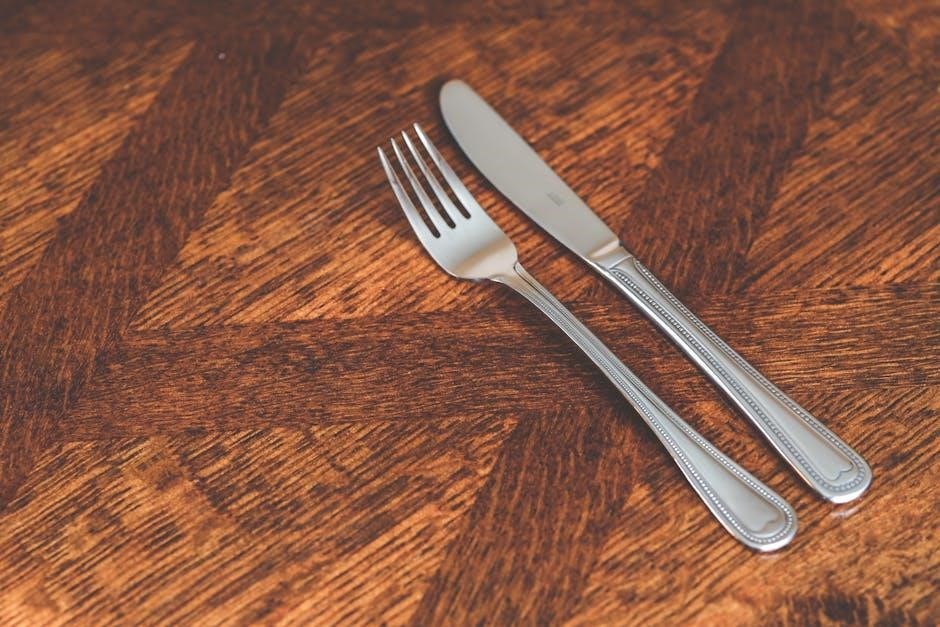
Knife Steel Performance Characteristics
Knife steel performance characteristics are crucial for understanding a blade’s hardness‚ edge retention‚ wear resistance‚ corrosion resistance‚ and toughness‚ helping determine the best steel for specific applications.
4.1 Hardness and Edge Retention
Hardness and edge retention are critical performance metrics in knife steel. Hardness‚ measured on the Rockwell C scale‚ determines a blade’s ability to resist deformation. Higher hardness levels‚ such as 60-62 HRC‚ typically correlate with superior edge retention‚ meaning the knife stays sharp longer. Carbon content is a key driver of hardness‚ as it strengthens the steel and enhances wear resistance. However‚ excessive hardness can compromise toughness‚ making the blade more prone to chipping or breaking under impact. Balancing these factors is essential for optimal performance.
4.2 Toughness and Impact Resistance
Toughness and impact resistance are vital for knives exposed to high-stress conditions. These properties ensure the blade can absorb impact without breaking or deforming. Chromium content plays a significant role in enhancing toughness‚ while microstructure and grain size also influence performance. Steels with higher toughness are ideal for applications requiring durability‚ such as tactical knives. However‚ increasing toughness often means sacrificing some hardness and edge retention‚ requiring a balance tailored to specific use cases.
4.3 Corrosion Resistance
Corrosion resistance is a critical property for knives exposed to moisture or harsh environments. Chromium content is key‚ as it forms a protective layer on the steel surface‚ preventing rust. Higher chromium levels‚ such as in stainless steels like 440C or S30V‚ enhance corrosion resistance. This makes them ideal for marine or culinary applications. However‚ increasing chromium can slightly reduce hardness and edge retention. Balancing these factors is essential for optimal performance in specific conditions.
4.4 Wear Resistance
Wear resistance measures how well a knife steel withstands abrasion and maintains its edge. High-carbon steels‚ like D2 and A2‚ excel in wear resistance due to their hardness and carbon content. Chromium and vanadium further enhance this property by forming hard‚ wear-resistant carbides. However‚ increased wear resistance often correlates with reduced toughness‚ making such steels more brittle. Balancing wear resistance with other properties like toughness is crucial for applications requiring durability and edge retention in demanding environments.
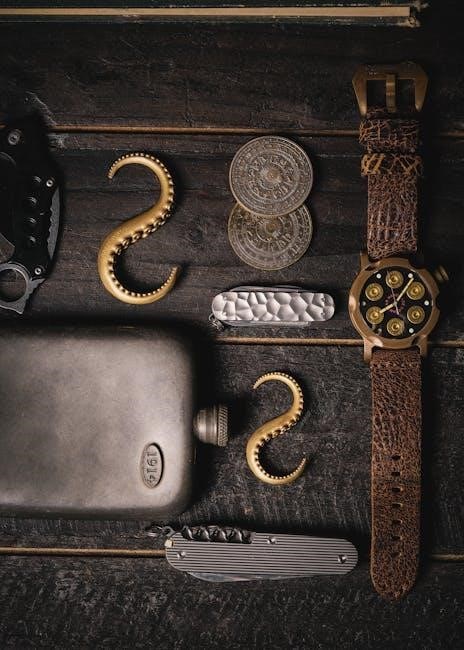
4.5 Sharpening Ease
Sharpening ease refers to how readily a knife steel can be honed to a sharp edge. Steels with higher hardness‚ such as high-carbon or tool steels‚ are more challenging to sharpen but hold their edge longer. Softer steels‚ like some stainless grades‚ sharpen more easily but may require more frequent maintenance. The choice depends on the user’s preference for convenience versus edge retention‚ as indicated in knife steel charts.
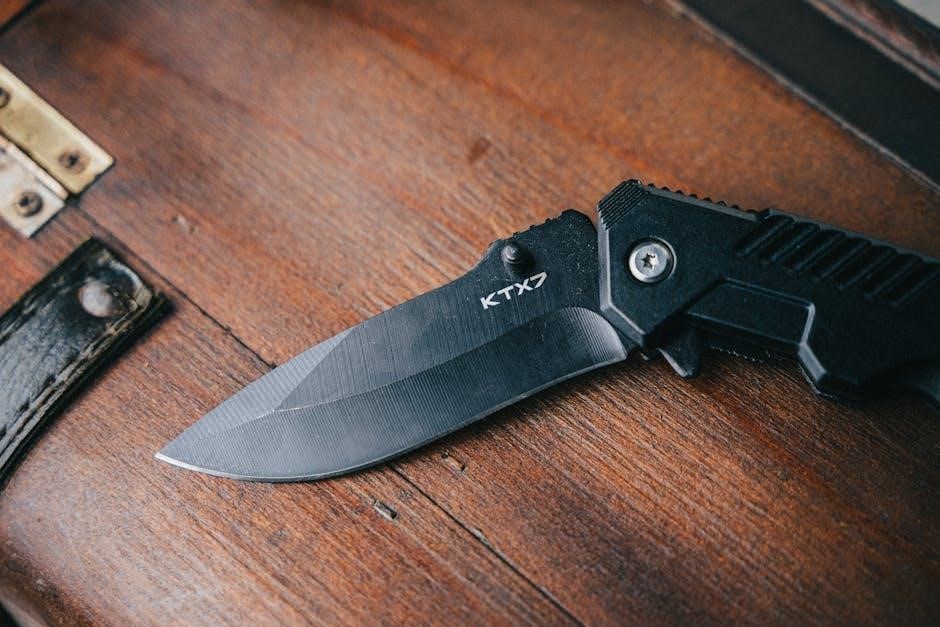
Popular Knife Steel Grades
Popular knife steel grades include 440C‚ D2‚ 154CM‚ S30V‚ and A2. These steels are renowned for their unique properties‚ such as corrosion resistance‚ hardness‚ and edge retention.
5.1 440C Stainless Steel
440C stainless steel is a high-carbon martensitic steel‚ offering excellent hardness and edge retention. It contains 16-18% chromium‚ making it highly corrosion-resistant. Commonly used in knives‚ it balances durability and resistance to rust‚ ideal for both everyday carry and marine environments. Its ability to maintain a sharp edge and withstand harsh conditions makes it a popular choice for high-end knives. The steel is heat-treatable to achieve a Rockwell hardness of approximately 60 HRC‚ enhancing its performance in demanding applications.
5.2 D2 Tool Steel
D2 tool steel is a high-carbon‚ high-chromium alloy known for its exceptional hardness‚ wear resistance‚ and toughness. It contains 1.5% carbon and 12% chromium‚ making it highly resistant to abrasive wear. Often used in heavy-duty knives‚ D2 offers excellent edge retention and durability‚ though it lacks the corrosion resistance of stainless steels. Its ability to withstand harsh environments makes it ideal for utility and tactical knives‚ where strength and longevity are prioritized over rust resistance. Heat-treated D2 can reach a Rockwell hardness of 60-62 HRC‚ ensuring superior performance in demanding applications.
5.3 154CM Stainless Steel
154CM stainless steel is a high-performance alloy known for its excellent balance of hardness‚ corrosion resistance‚ and edge retention. It contains 1.05% carbon‚ 14.5% chromium‚ 4% molybdenum‚ and 0.3% manganese. This composition allows it to achieve a Rockwell hardness of 60-62 HRC‚ making it ideal for high-end knives. Its high chromium content ensures strong corrosion resistance‚ while molybdenum enhances wear resistance. Widely used in both culinary and outdoor knives‚ 154CM offers durability‚ sharpness‚ and low maintenance‚ making it a popular choice for professionals and enthusiasts alike.
5.4 S30V Stainless Steel
S30V stainless steel is a high-performance‚ powder metallurgy steel renowned for its exceptional hardness‚ wear resistance‚ and corrosion resistance. With a composition of 1.45% carbon‚ 14% chromium‚ 3% vanadium‚ and 2% molybdenum‚ it achieves a Rockwell hardness of 59-61 HRC. Its fine grain structure enhances edge retention and sharpness‚ making it ideal for high-end knives. S30V is favored by enthusiasts and professionals for its durability and versatility‚ performing well in both tactical and culinary applications.
5.5 A2 Tool Steel
A2 tool steel is a high-carbon‚ air-hardening steel known for its exceptional toughness and wear resistance. With a Rockwell hardness of 57-62 HRC‚ it excels in applications requiring durability. Its composition includes chromium‚ molybdenum‚ and vanadium‚ enhancing its strength and edge retention. A2 is widely used in knives‚ tools‚ and industrial components due to its ability to withstand heavy use and resist abrasion. It is a popular choice for knife makers seeking a balance between hardness and toughness.
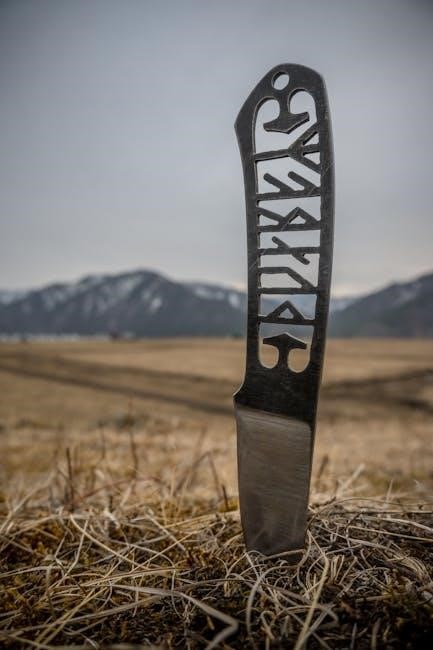
Knife Steel Comparison Charts
Knife steel comparison charts organize data on edge retention‚ corrosion resistance‚ hardness‚ and toughness‚ aiding users in selecting the best steel for specific knife applications and preferences.
6.1 Edge Retention vs. Corrosion Resistance
Knife steel charts compare edge retention and corrosion resistance‚ crucial for selecting the right steel. High carbon content enhances edge retention but may sacrifice corrosion resistance. Chromium boosts corrosion resistance but can slightly reduce hardness. Steels like 440C and S30V balance these properties‚ offering durability and rust resistance. Charts help users prioritize needs‚ whether for outdoor use or marine environments‚ ensuring the chosen steel meets specific demands. This comparison is vital for optimizing knife performance in various applications.
6.2 Hardness vs. Toughness
Knife steel charts highlight the trade-off between hardness and toughness. Hardness‚ measured on the Rockwell C scale‚ indicates resistance to wear and edge retention. Toughness refers to a steel’s ability to withstand impact without breaking. High hardness often means lower toughness‚ as harder steels can be brittle. Steels like D2 and 154CM balance these traits‚ offering durability and resistance to damage. Charts help users choose steels that suit their needs‚ ensuring optimal performance for specific tasks and environments.
6.3 Wear Resistance vs. Sharpening Ease
Knife steel charts often illustrate the balance between wear resistance and sharpening ease. Steels with higher carbon content typically offer superior wear resistance and edge retention but are more challenging to sharpen. For instance‚ 440C and D2 steels are known for their hardness‚ making them resistant to wear but tougher to sharpen. Softer steels‚ like A2‚ may sacrifice some edge retention for easier sharpening. Understanding this trade-off is crucial for selecting the right steel for the intended application‚ ensuring optimal performance and maintenance.
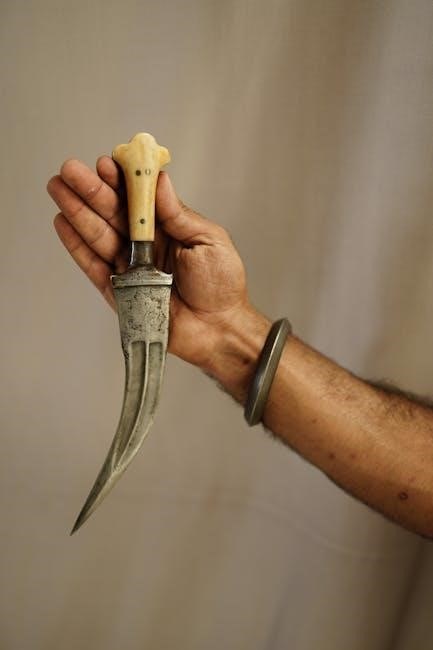
Applications of Knife Steel Charts
Knife steel charts are essential for selecting the right steel for industrial tools‚ culinary knives‚ outdoor gear‚ and collectibles‚ ensuring optimal performance and durability in various applications.
7.1 Industrial Applications
Knife steel charts are invaluable in industrial settings for selecting steels used in machinery‚ tools‚ and manufacturing processes. High-carbon martensitic stainless steels like 440C are favored for their hardness and wear resistance‚ while tool steels such as D2 and A2 are chosen for their durability in cutting and forming operations. These charts help industries optimize tool performance‚ reduce maintenance‚ and ensure reliability in heavy-duty applications‚ making them a critical resource for industrial efficiency and precision.
7.2 Kitchen Knives
Kitchen knives benefit greatly from knife steel charts‚ as they highlight steels like 440C and 154CM‚ known for their balance of hardness and corrosion resistance. These charts reveal how high-carbon stainless steels maintain sharpness and resist wear‚ crucial for culinary precision. By comparing edge retention and ease of sharpening‚ chefs and home cooks can select the ideal steel for their needs‚ ensuring durability and performance in demanding kitchen environments.
7.3 Outdoor and Tactical Knives
Knife steel charts are vital for outdoor and tactical knives‚ emphasizing durability and resilience. Steels like D2 and S30V are favored for their high hardness and wear resistance‚ crucial for heavy-duty tasks. These charts compare corrosion resistance and toughness‚ helping users choose steels that withstand harsh environments. Tactical knives often require a balance of edge retention and impact resistance‚ making such charts indispensable for selecting the right steel for survival‚ combat‚ or field applications.
7.4 Collectible Knives
Knife steel charts are invaluable for collectible knives‚ as they highlight the unique properties of rare and premium steels. These charts help enthusiasts understand the composition and performance of exotic steels like Damascus or high-carbon stainless steel. Collectors often seek knives with distinct patterns or exceptional edge retention‚ and the charts provide detailed insights into these characteristics. By referencing these guides‚ collectors can appreciate the craftsmanship and material quality that make their knives truly special.
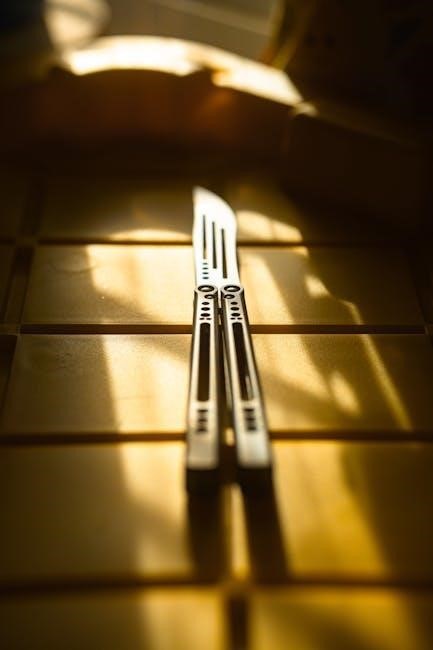
How to Read a Knife Steel Chart
Understanding a knife steel chart involves analyzing composition tables‚ interpreting performance metrics like hardness and corrosion resistance‚ and matching steels to specific knife uses effectively.
8.1 Understanding the Composition Table
The composition table in a knife steel chart lists the percentages of elements like carbon‚ chromium‚ and vanadium‚ which influence hardness‚ corrosion resistance‚ and edge retention. Each steel type is categorized‚ showing its alloying elements and their proportions. This table helps users identify how different elements contribute to a steel’s performance. For example‚ higher carbon content increases hardness and edge retention‚ while chromium enhances corrosion resistance. By analyzing this data‚ users can better understand how steel composition impacts knife performance and durability.
8.2 Interpreting Performance Metrics
Performance metrics in knife steel charts include hardness‚ toughness‚ corrosion resistance‚ and wear resistance. Hardness‚ measured in Rockwell C (HRC)‚ indicates edge retention. Higher HRC values mean a sharper‚ longer-lasting edge. Toughness refers to a knife’s ability to withstand impact without breaking. Corrosion resistance is crucial for knives exposed to moisture‚ often enhanced by chromium. Wear resistance reflects how well the steel withstands abrasion. By interpreting these metrics‚ users can match steel types to specific uses‚ ensuring optimal performance for their intended application‚ whether for culinary‚ outdoor‚ or tactical purposes.
8.3 Matching Steel to Intended Use
Matching steel to its intended use is crucial for optimal performance. For culinary knives‚ high-carbon stainless steels like 440C or 154CM are ideal due to their hardness and corrosion resistance. Outdoor knives benefit from tough‚ wear-resistant steels like D2 or A2. Tactical knives often use high-carbon stainless steels like S30V for edge retention and durability. Collectible knives may prioritize aesthetics and unique compositions‚ such as Damascus steel. Referencing a knife steel chart helps users align steel properties with their specific needs‚ ensuring the best results for each application.
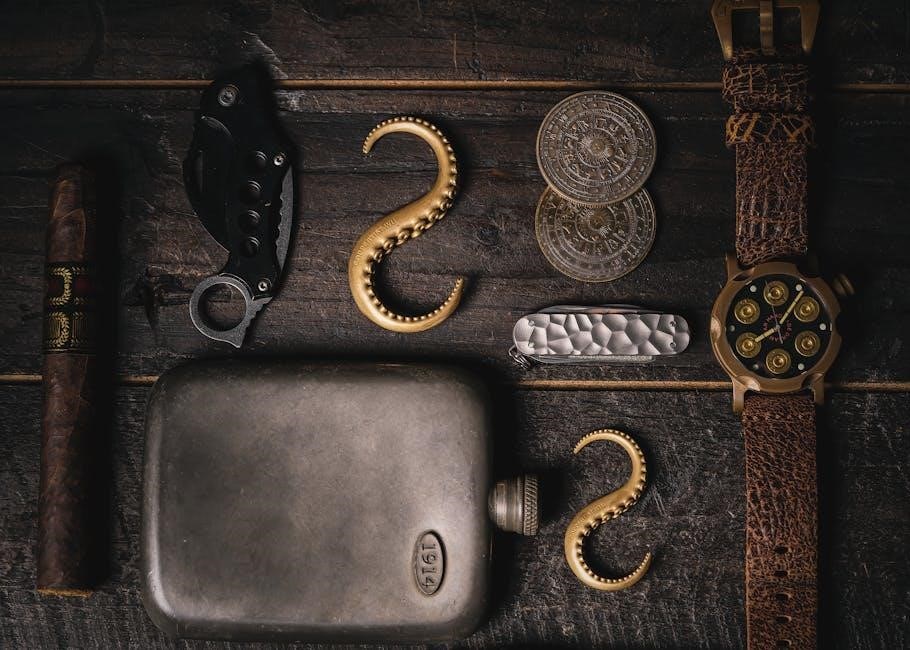
Resources and Further Reading
Explore comprehensive knife steel guides‚ PDF charts‚ and online tools for detailed steel comparisons. Recommended reading includes specialized books and articles on steel composition and applications.
9.1 Knife Steel Chart PDF Downloads
Knife steel chart PDFs are widely available online‚ offering detailed compositions and properties of various steels. Websites like SB Specialty Metals provide comprehensive charts‚ while Daido Steel offers chemical composition guides. These PDFs include tables‚ performance metrics‚ and application insights‚ making them invaluable for knife enthusiasts and professionals. Download these resources to compare steels like 440C‚ D2‚ and S30V‚ aiding in informed decisions for knife-making or purchasing. They serve as essential tools for understanding blade materials.
9.2 Online Tools and Interactive Charts
Interactive knife steel charts and online tools offer dynamic ways to explore steel properties and compare different types. Websites provide sortable tables and visual graphs for elements like carbon‚ chromium‚ and vanadium. These tools allow users to filter steels by performance metrics such as hardness‚ corrosion resistance‚ and edge retention. Some platforms also offer downloadable PDF guides for offline use‚ making it easier to reference steel compositions and properties. These resources are invaluable for enthusiasts and professionals seeking detailed steel comparisons.
9.3 Recommended Reading Materials
For deeper understanding‚ downloadable PDF guides like the Knife Steel Chart PDF and comprehensive steel composition manuals are highly recommended. These resources detail properties‚ applications‚ and performance metrics of various steels‚ such as 440C and D2. They also provide insights into alloying elements and their effects on blade performance. These materials are ideal for enthusiasts and professionals seeking to enhance their knowledge of knife steel characteristics and selection criteria.
